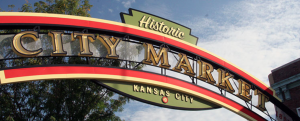Cities tend to get established for various geographical attributes and the confluence of the Missouri and Kansas Rivers is a perfect example. River travel was among the earliest forms of conveyance in the discovery and settling of the American West. There is so much history to the part of our town we now call River Market, that it is hard to digest. It is the oldest settled part of our city, dating back to about 1821, when Francois Chouteau established the first European settlement (Chouteau’s Landing), on the river bank as a location for his fur trading operation. The area later became known as Westport Landing because goods were offloaded from riverboats to supply the town of Westport. It later developed some confusing names such as Town of Kansas (1850) and City of Kansas (1853), even though it is located in Missouri.  Photo Credit: Visit KC As the area grew it became a mercantile hub for the area with the attending good and bad characteristics of nascent communities. Many warehouses sprung up, but other venues flourished as well. Bordellos, such as Annie Chamber’s Brothel and Madame Lovejoy’s, were established around 3rd and Wyandotte. The Pacific House, then the area’s finest hotel, opened in 1861, and still stands on the east side of Delaware Street. It was home to Union troops during the Civil War and was the site of General Thomas Ewing’s famous Proclamation 11, which forced the evacuation of anyone owning property who could not prove allegiance to the Union. The area also fostered the first open air farm to market venue in Kansas City, which still remains vibrant on weekends and draws people from miles away. But, by the middle of the last century, commercial river traffic had ceased and the once vibrant riverfront area had slipped into obscurity. Eventually, developer Mario Trozzolo coined the name River Quay in the 1970’s to attract new commercial and entertainment activity. It wasn’t long after that, however, the underbelly of Kansas City was exposed. Bars and restaurants sprang up all over the area and vehicular traffic was all but impossible to navigate on Delaware during the frenetic weekend nights. Venues like Judge Roy Bean’s, Huck Finn’s, Madame Lovejoy’s and Mama Angelina’s were popular destinations until organized crime made its presence felt. A lot of properties were owned or operated by Italian families, which became embroiled in a Gang War within the local branch of the Mafia. That dispute resulted in bombings of restaurants and murders. The result was that the area became a virtual ghost town for recreation in the 1980’s. Its toxic reputation ameliorated over time and it was rechristened the River Market, which has enjoyed a resurgence of activity. Old warehouses have been repurposed as lofts. Restaurants and bars have returned to service the residents and accommodate considerable traffic from other parts of the community. The Arabian Steamboat Museum is a tourist destination. Ethnic markets and food venues have arisen. Nearby Berkley Riverfront Park offers some nice greenspace. New condominiums and offices are being built. One can’t help but wonder what Francois Chouteau would think if he saw the present River Market. A fly on the wall of the Pacific House would have amazing stories to tell.
Photo Credit: Visit KC As the area grew it became a mercantile hub for the area with the attending good and bad characteristics of nascent communities. Many warehouses sprung up, but other venues flourished as well. Bordellos, such as Annie Chamber’s Brothel and Madame Lovejoy’s, were established around 3rd and Wyandotte. The Pacific House, then the area’s finest hotel, opened in 1861, and still stands on the east side of Delaware Street. It was home to Union troops during the Civil War and was the site of General Thomas Ewing’s famous Proclamation 11, which forced the evacuation of anyone owning property who could not prove allegiance to the Union. The area also fostered the first open air farm to market venue in Kansas City, which still remains vibrant on weekends and draws people from miles away. But, by the middle of the last century, commercial river traffic had ceased and the once vibrant riverfront area had slipped into obscurity. Eventually, developer Mario Trozzolo coined the name River Quay in the 1970’s to attract new commercial and entertainment activity. It wasn’t long after that, however, the underbelly of Kansas City was exposed. Bars and restaurants sprang up all over the area and vehicular traffic was all but impossible to navigate on Delaware during the frenetic weekend nights. Venues like Judge Roy Bean’s, Huck Finn’s, Madame Lovejoy’s and Mama Angelina’s were popular destinations until organized crime made its presence felt. A lot of properties were owned or operated by Italian families, which became embroiled in a Gang War within the local branch of the Mafia. That dispute resulted in bombings of restaurants and murders. The result was that the area became a virtual ghost town for recreation in the 1980’s. Its toxic reputation ameliorated over time and it was rechristened the River Market, which has enjoyed a resurgence of activity. Old warehouses have been repurposed as lofts. Restaurants and bars have returned to service the residents and accommodate considerable traffic from other parts of the community. The Arabian Steamboat Museum is a tourist destination. Ethnic markets and food venues have arisen. Nearby Berkley Riverfront Park offers some nice greenspace. New condominiums and offices are being built. One can’t help but wonder what Francois Chouteau would think if he saw the present River Market. A fly on the wall of the Pacific House would have amazing stories to tell.
Footer
© Van Osdol, PC. All rights reserved.
The choice of a lawyer is an important decision and should not be based solely upon advertisements.

